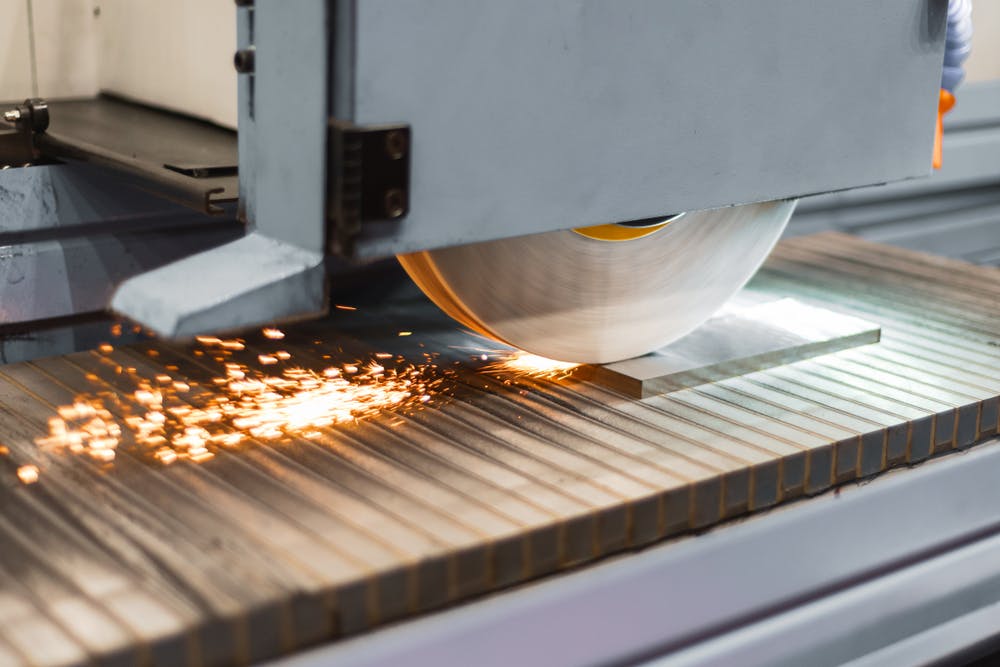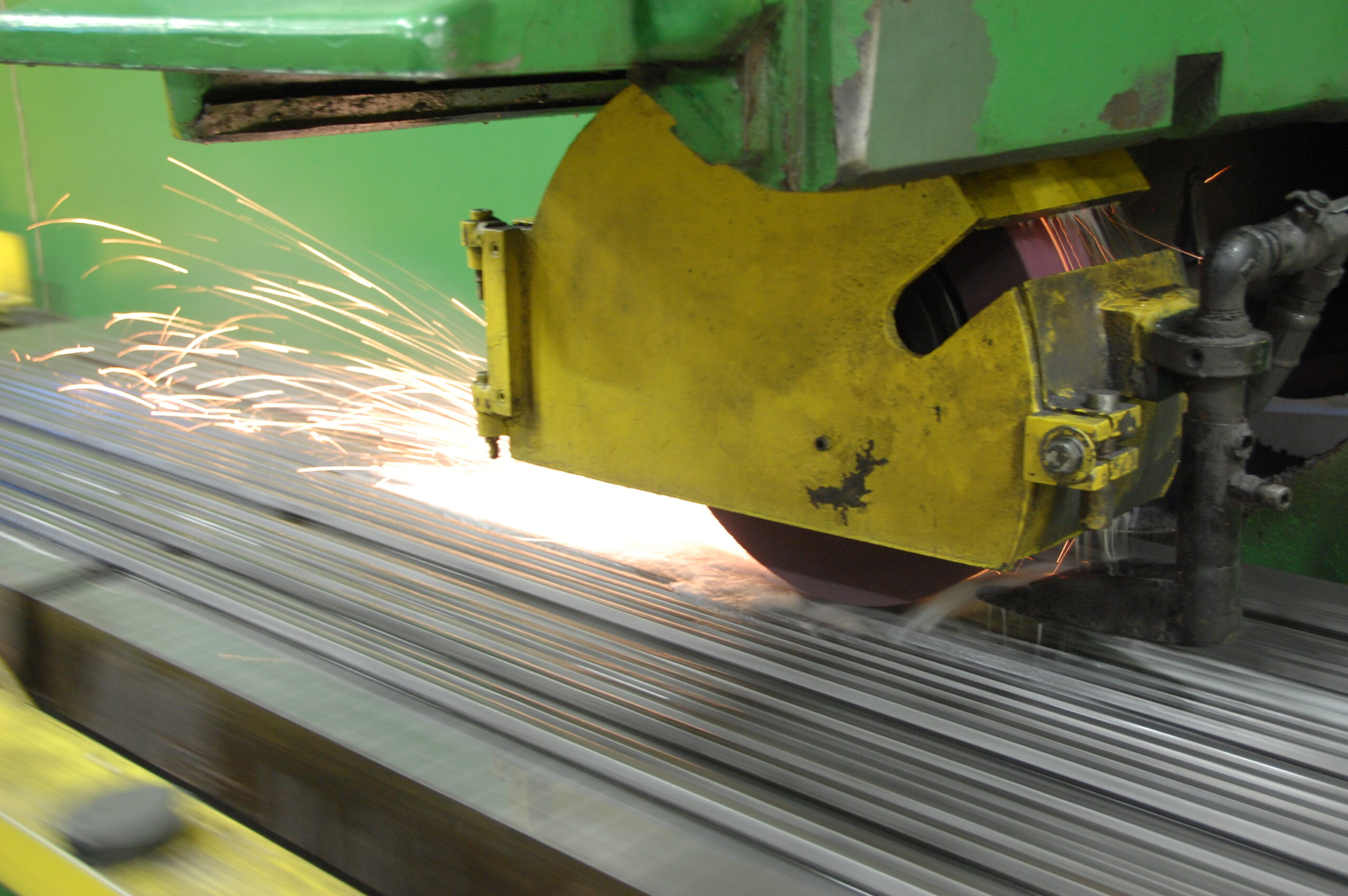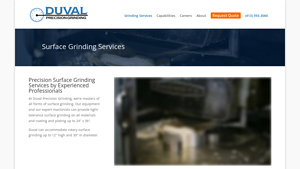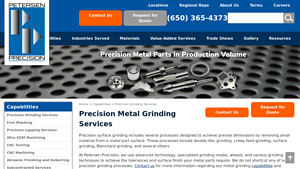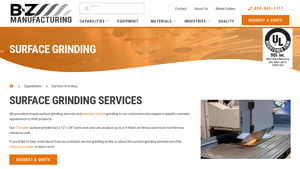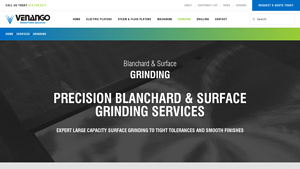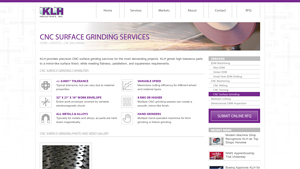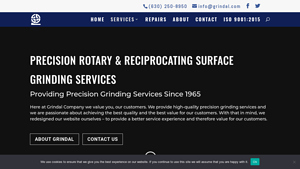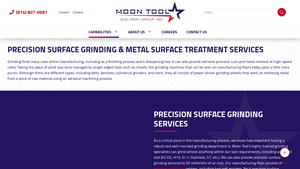Surface Grinding Services Guide: Type, Cost, Top List…
Introduction: Navigating the Global Market for surface grinding services
In today’s competitive landscape, sourcing surface grinding services that meet precision and quality standards can be a formidable challenge for international B2B buyers. As industries across Africa, South America, the Middle East, and Europe, including key markets like Brazil and Germany, increasingly demand high-tolerance machining solutions, understanding the nuances of surface grinding becomes essential. This guide is designed to assist you in navigating the complexities of the global market for surface grinding services, empowering you to make informed purchasing decisions.
Within these pages, we will delve into various types of surface grinding techniques, their specific applications across different industries, and the critical factors to consider when vetting potential suppliers. You will gain insights into cost structures, timelines for delivery, and the importance of quality assurance in maintaining the integrity of your projects. By equipping yourself with this knowledge, you can confidently select the right service providers who align with your technical requirements and business goals.
Whether you are in aerospace, automotive, or general manufacturing, this comprehensive guide is your key to unlocking the potential of surface grinding services. By understanding the market dynamics and the capabilities of various suppliers, you will enhance your procurement strategy and ensure that your operations run smoothly and efficiently.
Understanding surface grinding services Types and Variations
| Type Name | Key Distinguishing Features | Primary B2B Applications | Brief Pros & Cons for Buyers |
|---|---|---|---|
| Flat Surface Grinding | Precision removal of material to achieve a flat finish. | Aerospace, automotive, and mold manufacturing. | Pros: High precision; suitable for large surfaces. Cons: Slower processing for thicker materials. |
| Rotary Surface Grinding | Uses a rotating grinding wheel for efficient material removal. | Production of large components and castings. | Pros: Fast processing; consistent surface finish. Cons: Limited to certain geometries. |
| Blanchard Grinding | Large capacity grinding with a cross-hatched finish. | Heavy machinery, large plates, and castings. | Pros: Quick stock removal; ideal for large parts. Cons: Less precision than flat grinding methods. |
| CNC Surface Grinding | Computer-controlled for high accuracy and repeatability. | High-volume production and complex geometries. | Pros: Exceptional precision; programmable for repeat jobs. Cons: Higher setup costs; requires skilled operators. |
| Precision Surface Grinding | Tight tolerances and fine surface finishes. | Medical devices, aerospace components. | Pros: Extremely tight tolerances; high-quality finishes. Cons: Longer lead times; more expensive. |
What are the Characteristics and Suitability of Flat Surface Grinding?
Flat surface grinding is primarily focused on achieving a perfectly flat surface finish on workpieces. This method is suitable for applications requiring high precision, such as aerospace and automotive components, where tolerances can be as tight as ±0.0001 inches. Buyers should consider the size and type of materials being processed, as thicker materials may lead to slower processing times.
How Does Rotary Surface Grinding Differ from Other Methods?
Rotary surface grinding employs a rotating wheel, allowing for efficient material removal and consistent finishes. This method is ideal for large components and castings, making it popular in industries like manufacturing. Buyers should note that while rotary grinding speeds up production, it may be limited to specific geometrical requirements, which could affect design flexibility.
What Advantages Does Blanchard Grinding Offer for Large Parts?
Blanchard grinding is characterized by its ability to handle large parts with a cross-hatched finish, making it a preferred choice for heavy machinery and large plates. This technique allows for rapid stock removal, which is advantageous for high-volume production. However, buyers should be aware that Blanchard grinding may not achieve the same precision as other methods, potentially affecting applications that require tighter tolerances.
Why Choose CNC Surface Grinding for Complex Geometries?
CNC surface grinding utilizes computer-controlled machines to provide high accuracy and repeatability, making it suitable for high-volume production and intricate designs. This method is particularly beneficial in industries that demand precision, such as medical device manufacturing. However, the initial setup costs and the need for skilled operators should be considered by buyers when evaluating this option.
What Makes Precision Surface Grinding Essential for High-Quality Finishes?
Precision surface grinding is essential for applications requiring extremely tight tolerances and superior surface finishes, such as in the medical and aerospace sectors. This method ensures high-quality results but may involve longer lead times and higher costs. Buyers should weigh the benefits of precision against their project timelines and budget constraints when selecting this grinding service.
Key Industrial Applications of surface grinding services
| Industry/Sector | Specific Application of Surface Grinding Services | Value/Benefit for the Business | Key Sourcing Considerations for this Application |
|---|---|---|---|
| Aerospace | Precision components for aircraft engines | Ensures reliability and safety in flight operations | Tolerance requirements, material specifications, and certifications are critical. |
| Automotive | Engine blocks and transmission housings | Enhances performance and efficiency of vehicles | Need for high-quality finishes, tight tolerances, and rapid turnaround times. |
| Medical Devices | Surgical instruments and implants | Critical for patient safety and device efficacy | Compliance with stringent industry standards and material biocompatibility is essential. |
| Tool and Die Manufacturing | Molds and dies for manufacturing processes | Improves product quality and reduces production costs | Consideration for material hardness and wear resistance is vital. |
| Electronics | Heat sinks and enclosures for electronic devices | Enhances thermal management and device longevity | Precision in surface finish and dimensional accuracy is crucial. |
How Are Surface Grinding Services Applied in the Aerospace Industry?
In the aerospace sector, surface grinding services are vital for manufacturing precision components such as turbine blades and engine casings. These parts must meet stringent safety and reliability standards, which require tight tolerances and exceptional surface finishes. For international buyers, particularly in regions like Europe and the Middle East, sourcing from certified vendors ensures compliance with regulations like AS9100, which governs aerospace quality management systems.
What Role Do Surface Grinding Services Play in the Automotive Sector?
Surface grinding is extensively used in the automotive industry for producing engine blocks and transmission housings, where precision is critical for performance and efficiency. The ability to achieve high-quality finishes and tight tolerances directly impacts the overall functionality of vehicle components. Buyers in South America and Africa should prioritize suppliers who can deliver on quick turnaround times while maintaining high standards of quality assurance.
Why Are Surface Grinding Services Essential for Medical Devices?
In the medical device industry, surface grinding services are employed to manufacture surgical instruments and implants that require meticulous precision. The surface quality directly affects the safety and efficacy of medical devices, making compliance with industry standards crucial. Buyers should look for suppliers with certifications in ISO 13485, ensuring that processes meet the specific needs of medical applications, especially when sourcing from international markets.
How Do Surface Grinding Services Benefit Tool and Die Manufacturing?
Surface grinding services are integral to the tool and die manufacturing process, where molds and dies are crafted to ensure high-quality production of various components. The precision achieved through grinding reduces production costs and improves product quality by minimizing defects. For buyers, especially in Europe and Africa, understanding the specific requirements for material hardness and wear resistance is essential when selecting a grinding service provider.
How Are Surface Grinding Services Used in Electronics Manufacturing?
In the electronics industry, surface grinding is crucial for creating heat sinks and enclosures that enhance thermal management in devices. The precision of surface grinding ensures that these components fit perfectly and function efficiently, extending the lifespan of electronic products. International buyers should focus on suppliers who can guarantee high dimensional accuracy and surface finish, as these factors are critical for optimal performance in electronic applications.
3 Common User Pain Points for ‘surface grinding services’ & Their Solutions
Scenario 1: Precision Tolerance Requirements for Aerospace Components
The Problem: For B2B buyers in the aerospace industry, the demand for precision and reliability is paramount. A common challenge arises when sourcing surface grinding services that can meet the stringent tolerances required for aerospace components. Buyers often find that not all service providers can achieve the necessary flatness and dimensional accuracy, leading to potential delays in production and increased costs due to rework or scrap.
The Solution: To effectively address this challenge, buyers should prioritize vendors with proven expertise in aerospace applications and a robust quality assurance process. When evaluating potential surface grinding service providers, request detailed documentation of their capabilities, including tolerance levels, equipment specifications, and past performance metrics. Engaging in discussions about their quality control measures, such as in-process measurements and final inspection protocols, can also provide insight into their reliability. Establishing a partnership with a vendor that utilizes advanced technology and possesses experience in aerospace components will ensure that precision requirements are consistently met, reducing the risk of costly production setbacks.
Scenario 2: Material Compatibility and Grinding Performance Issues
The Problem: Buyers often face difficulties when dealing with a variety of materials that exhibit different responses to surface grinding. For instance, materials like aluminum and certain plastics can clog grinding wheels, leading to poor surface finishes and extended processing times. This not only affects the quality of the finished product but can also result in unexpected increases in operational costs.
The Solution: To mitigate material compatibility issues, it is crucial for buyers to communicate their specific material requirements to potential surface grinding service providers. When sourcing services, inquire about the vendor’s experience with your specific materials and their strategies for managing challenges associated with them. For example, ask if they utilize specialized grinding wheels designed for softer materials or if they implement techniques like using high coolant levels or shallow cuts to avoid clogging. Additionally, conducting a material compatibility assessment during the quoting process can help identify potential issues early on, allowing for the selection of the most suitable grinding methods and enhancing overall production efficiency.
Scenario 3: Turnaround Time and Project Deadlines
The Problem: In competitive markets, B2B buyers often contend with tight project deadlines that necessitate quick turnaround times for surface grinding services. Delays in grinding operations can cascade through the supply chain, ultimately affecting delivery schedules and client satisfaction. Buyers may struggle to find reliable vendors who can accommodate urgent requests without compromising quality.
The Solution: To overcome this issue, buyers should establish clear timelines and project requirements upfront when engaging with surface grinding service providers. It is advisable to inquire about the vendor’s capacity to handle urgent requests and their typical lead times for various types of grinding services. Developing a strong relationship with a select few vendors can facilitate quicker responses and priority treatment for urgent jobs. Moreover, buyers should consider implementing a vendor management system that includes performance metrics on turnaround times and service reliability. This data-driven approach will not only help identify the most responsive suppliers but also enable better forecasting and planning for future projects, ensuring that deadlines are consistently met.
Strategic Material Selection Guide for surface grinding services
What Are the Key Properties of Common Materials Used in Surface Grinding Services?
When selecting materials for surface grinding services, understanding their properties is crucial for optimizing performance and ensuring compliance with industry standards. Below, we analyze four common materials—stainless steel, aluminum, brass, and cast iron—highlighting their key properties, pros and cons, and considerations for international B2B buyers.
How Does Stainless Steel Perform in Surface Grinding Applications?
Key Properties: Stainless steel is known for its excellent corrosion resistance, high strength, and durability. It can withstand high temperatures and pressures, making it suitable for demanding applications.
Pros & Cons: The primary advantage of stainless steel is its resistance to rust and staining, which prolongs the lifespan of components. However, it can be more expensive than other materials and may require specialized grinding techniques to avoid work hardening during machining.
Impact on Application: Stainless steel is commonly used in industries such as aerospace and food processing, where hygiene and durability are paramount. Its compatibility with various media makes it a preferred choice for high-performance applications.
Considerations for International Buyers: Buyers from regions like Europe and the Middle East should be aware of compliance with standards such as ASTM A240 and DIN 17440. The preference for specific grades (like 304 or 316) may vary based on local regulations and industry requirements.
What Are the Benefits and Limitations of Using Aluminum in Surface Grinding?
Key Properties: Aluminum is lightweight and has good corrosion resistance, but it has a lower melting point compared to other metals, which can impact its performance under high temperatures.
Pros & Cons: Aluminum is cost-effective and easy to machine, making it suitable for a variety of applications. However, it tends to clog grinding wheels, which can lead to surface imperfections if not managed correctly.
Impact on Application: Its lightweight nature is beneficial in automotive and aerospace applications where reducing weight is critical. However, the need for careful handling during grinding can complicate production processes.
Considerations for International Buyers: Buyers should consider the availability of specific aluminum grades and compliance with standards such as ASTM B221. In regions like South America, understanding the local supply chain for aluminum products is crucial to avoid delays.
Why Choose Brass for Surface Grinding Services?
Key Properties: Brass is an alloy of copper and zinc, known for its excellent machinability and corrosion resistance, particularly in marine environments.
Pros & Cons: The key advantage of brass is its aesthetic appeal and ease of machining, which makes it ideal for decorative applications. However, it is generally more expensive than steel and can be less durable under high-stress conditions.
Impact on Application: Brass is often used in fittings, valves, and musical instruments. Its compatibility with various environments makes it a versatile choice for many applications.
Considerations for International Buyers: Compliance with standards like ASTM B16 is essential, especially for buyers in Europe and Africa. Understanding the local market dynamics can help in sourcing high-quality brass at competitive prices.
What Are the Advantages of Cast Iron for Surface Grinding?
Key Properties: Cast iron is known for its excellent wear resistance and ability to absorb vibrations, making it ideal for precision machining.
Pros & Cons: The primary advantage of cast iron is its durability and cost-effectiveness, especially for large components. However, it can be brittle and may require careful handling to avoid cracking during grinding.
Impact on Application: Commonly used in machine bases and heavy-duty applications, cast iron’s properties make it suitable for industries such as manufacturing and construction.
Considerations for International Buyers: Buyers should be aware of standards such as ASTM A48 for gray cast iron. In regions like Africa, sourcing high-quality cast iron can be challenging, and understanding local suppliers is crucial.
Summary Table of Material Selection for Surface Grinding Services
| Material | Typical Use Case for surface grinding services | Key Advantage | Key Disadvantage/Limitation | Relative Cost (Low/Med/High) |
|---|---|---|---|---|
| Stainless Steel | Aerospace components, food processing equipment | Excellent corrosion resistance | Higher cost, work hardening issues | High |
| Aluminum | Automotive parts, aerospace components | Lightweight and cost-effective | Clogging issues during grinding | Medium |
| Brass | Fittings, valves, decorative items | Excellent machinability | More expensive, less durable | Medium |
| Cast Iron | Machine bases, heavy-duty applications | Durable and cost-effective | Brittle, requires careful handling | Low |
This guide provides a comprehensive overview of the strategic material selection process for surface grinding services, helping international B2B buyers make informed decisions based on material properties, application suitability, and compliance considerations.
In-depth Look: Manufacturing Processes and Quality Assurance for surface grinding services
What Are the Key Stages in the Manufacturing Process for Surface Grinding Services?
The manufacturing process for surface grinding services is intricate, involving several key stages that ensure precision and quality. Understanding these stages is crucial for B2B buyers looking to source reliable surface grinding services, especially when dealing with international suppliers.
Material Preparation: What Steps Are Involved?
Before surface grinding can begin, thorough material preparation is essential. This includes selecting the appropriate material based on the project requirements, which may range from metals like stainless steel and cast iron to plastics and composites. The material must be clean and free from contaminants to avoid defects during grinding.
Once the material is selected, it is often cut to size using saws or other cutting methods to ensure it fits the grinding machine. This is followed by a visual inspection to check for any surface irregularities or damage that could affect the grinding process. Proper material preparation sets the foundation for achieving the desired tolerances and surface finishes.
How Is the Surface Grinding Process Executed?
The surface grinding process itself involves several key techniques, primarily using a rotating grinding wheel made of abrasive materials. The workpiece is securely mounted on a magnetic chuck, allowing for precise positioning during grinding.
Typically, there are two main types of surface grinding: flat grinding and rotary grinding. Flat grinding is employed for achieving precise flat surfaces, while rotary grinding is ideal for larger workpieces, providing a consistent surface finish due to the circular motion of the grinding wheel.
During the grinding operation, the wheel is dressed to maintain its sharpness and effectiveness. This dressing process ensures that the wheel can consistently remove material from the workpiece without causing overheating or damage. Coolant is also utilized to dissipate heat and remove debris, which is critical for maintaining the integrity of both the grinding wheel and the workpiece.
What Are the Finishing Techniques Used in Surface Grinding?
After the initial grinding, additional finishing techniques may be applied to achieve the desired surface quality. Techniques such as lapping and honing can further refine the surface finish, enhancing precision and reducing roughness.
Lapping involves a loose abrasive and is typically used for achieving ultra-flat surfaces, while honing is a process that improves the surface finish and geometric accuracy of the workpiece. These finishing techniques are especially important in industries like aerospace and automotive, where component reliability is paramount.
How Is Quality Assurance Maintained in Surface Grinding Services?
Quality assurance (QA) is critical in surface grinding services to ensure that the finished products meet the required specifications and standards. For B2B buyers, understanding QA protocols can help in selecting the right supplier.
What International Standards Should Buyers Be Aware Of?
Most reputable surface grinding service providers adhere to international quality standards such as ISO 9001, which outlines a framework for quality management systems. Compliance with ISO standards ensures that the supplier maintains consistent quality and can effectively manage processes to meet customer needs.
In addition to ISO standards, industry-specific certifications such as CE (Conformité Européenne) for European markets and API (American Petroleum Institute) for oil and gas applications are also critical. These certifications indicate that the supplier meets the necessary safety and quality requirements for specific industries.
What Are the Key Quality Control Checkpoints?
Quality control (QC) during the surface grinding process typically involves several checkpoints, including:
-
Incoming Quality Control (IQC): Materials are inspected upon arrival at the facility to ensure they meet specified standards before processing.
-
In-Process Quality Control (IPQC): Continuous monitoring during the grinding process helps identify any deviations from quality standards. This includes checking tolerances and surface finishes at various stages.
-
Final Quality Control (FQC): After grinding, the finished products undergo thorough inspections to verify that they meet all specified requirements before delivery.
Common testing methods include dimensional checks using calipers and micrometers, surface roughness testing, and non-destructive testing methods like ultrasonic or magnetic particle inspection.
How Can B2B Buyers Verify a Supplier’s Quality Control?
For international B2B buyers, verifying a supplier’s quality control measures is crucial in mitigating risks associated with sourcing. Here are several strategies to ensure that a potential supplier adheres to high-quality standards:
What Steps Can Be Taken for Supplier Audits?
Conducting supplier audits is one of the most effective ways to assess a supplier’s quality control processes. This can be done through on-site visits or third-party inspections, focusing on the supplier’s manufacturing capabilities, quality management systems, and adherence to international standards.
Buyers should also request documentation of quality control procedures, including inspection reports and certificates of compliance. A well-documented QC process indicates that the supplier is committed to maintaining high standards.
How Important Are Reports and Third-Party Inspections?
Requesting regular quality reports from suppliers is essential for transparency. These reports should detail inspection results, any non-conformities, and corrective actions taken. Additionally, third-party inspections can provide an unbiased evaluation of the supplier’s quality practices, adding an extra layer of assurance for buyers.
What Nuances Should International Buyers Consider Regarding Quality Control?
When dealing with suppliers from diverse regions, it is crucial for B2B buyers to understand the cultural and regulatory differences that may affect quality control practices. For example, suppliers in Africa and South America may have different compliance requirements compared to those in Europe or the Middle East. Understanding these nuances can help buyers navigate potential challenges and foster better supplier relationships.
Moreover, buyers should be aware of any additional certifications or quality guarantees that may be specific to the regions they are sourcing from. This knowledge can aid in making informed decisions and ensuring that the products meet their expectations.
In conclusion, a comprehensive understanding of the manufacturing processes and quality assurance measures involved in surface grinding services is essential for B2B buyers. By focusing on material preparation, grinding techniques, and stringent quality control practices, buyers can select reliable suppliers that meet their specific needs and expectations.
Practical Sourcing Guide: A Step-by-Step Checklist for ‘surface grinding services’
To successfully procure surface grinding services, it is essential to follow a structured approach that ensures quality, precision, and reliability. This guide provides a step-by-step checklist designed for international B2B buyers, particularly those operating in diverse markets such as Africa, South America, the Middle East, and Europe.
Step 1: Define Your Technical Specifications
Begin by clearly outlining the specific requirements for your surface grinding project. This includes dimensions, tolerances, and the types of materials to be processed.
– Considerations: Identify whether you require flat surface grinding, rotary grinding, or another specialized method, as different techniques may suit varying applications.
– Documentation: Create a detailed technical datasheet to communicate your needs effectively to potential suppliers.
Step 2: Research Potential Suppliers
Conduct thorough research to identify suppliers that specialize in surface grinding services. Look for companies with a proven track record in your industry.
– Resources: Utilize online platforms, industry directories, and trade shows to gather a list of potential vendors.
– Geographical Reach: Ensure that the suppliers can accommodate international shipping or have local representatives in your region.
Step 3: Evaluate Supplier Capabilities
Assess each supplier’s grinding capabilities to ensure they align with your project requirements. This includes maximum dimensions, tolerances, and material types they can handle.
– Key Metrics: Inquire about their machinery specifications and the types of grinding wheels used, as these directly affect the quality of the finished product.
– Quality Standards: Ask about their adherence to industry standards and certifications, such as ISO 9001, to ensure consistent quality.
Step 4: Request Quotes and Compare Pricing
After narrowing down potential suppliers, request detailed quotes that outline pricing, lead times, and terms of service.
– Cost Breakdown: Ensure that quotes include all costs associated with the project, such as setup fees and shipping charges.
– Value Assessment: Compare not just the prices but also the value offered, including quality assurance processes and customer support.
Step 5: Check References and Reviews
Before making a final decision, verify the credibility of the suppliers by checking references and customer reviews.
– Peer Feedback: Reach out to previous clients to understand their experiences regarding quality, timeliness, and communication.
– Online Reviews: Explore third-party review platforms to gain insights into the supplier’s reputation in the market.
Step 6: Conduct a Site Visit (If Possible)
If feasible, arrange a site visit to the supplier’s facility to evaluate their operations firsthand.
– Operational Insight: Observe their equipment, processes, and quality control measures in action to gauge their capability.
– Relationship Building: A personal visit can also help establish a strong working relationship and open lines of communication.
Step 7: Finalize Contractual Agreements
Once you have selected a supplier, ensure that all terms are clearly defined in a contractual agreement.
– Key Elements: The contract should outline project specifications, timelines, payment terms, and penalties for non-compliance.
– Flexibility Clauses: Include provisions for potential changes in project scope or unforeseen circumstances to protect both parties.
By following this practical checklist, B2B buyers can streamline their sourcing process for surface grinding services, ensuring they partner with a supplier that meets their technical needs and business objectives.
Comprehensive Cost and Pricing Analysis for surface grinding services Sourcing
What Are the Key Cost Components in Surface Grinding Services?
When sourcing surface grinding services, understanding the cost structure is vital. The primary components that contribute to the overall cost include:
-
Materials: The cost of materials is influenced by the type of metal or component being processed. For instance, harder materials like stainless steel or titanium generally incur higher costs due to the increased wear on grinding tools and the need for specialized equipment.
-
Labor: Skilled labor is essential for precision grinding. The expertise required to operate grinding machines and ensure the desired tolerances can significantly affect labor costs. Regions with a skilled workforce may offer better pricing but can also have higher wage expectations.
-
Manufacturing Overhead: This includes the costs associated with the facility, utilities, and equipment maintenance. Companies that maintain a climate-controlled environment, like Duval Precision Grinding, may charge more for overhead costs to ensure quality and accuracy.
-
Tooling: Tooling costs encompass the grinding wheels and other consumables needed for the process. High-quality tools, particularly those suitable for tough materials, will be more expensive but can improve efficiency and finish quality.
-
Quality Control (QC): Rigorous QC procedures ensure that the grinding service meets specified tolerances and surface finishes. The investment in quality assurance can impact pricing but is critical for industries requiring high precision, such as aerospace and automotive.
-
Logistics: Transportation costs can vary widely based on the location of the buyer and supplier, especially for international shipments. Understanding Incoterms is crucial for managing these costs effectively.
-
Margin: Finally, suppliers will include a profit margin in their pricing. This margin can vary based on the supplier’s market position, reputation, and service quality.
How Do Price Influencers Affect Surface Grinding Service Costs?
Several factors can influence pricing for surface grinding services:
-
Volume and Minimum Order Quantity (MOQ): Larger orders often attract bulk pricing discounts. Buyers should consider their projected needs to negotiate better rates based on anticipated volumes.
-
Specifications and Customization: Custom specifications, such as tighter tolerances or unique surface finishes, can increase costs. Suppliers may charge more for specialized services that require additional setup or tooling.
-
Material Type: As mentioned, different materials have varying grinding characteristics and costs. Understanding the material’s properties can help buyers anticipate potential challenges and costs.
-
Quality Certifications: Suppliers with specific industry certifications (e.g., ISO) may charge a premium for their services, reflecting their commitment to quality and reliability.
-
Supplier Factors: The supplier’s location, reputation, and production capabilities can affect pricing. Established suppliers with a proven track record may command higher prices due to their reliability and quality assurance processes.
-
Incoterms: International shipping terms can significantly impact the total cost. Buyers should clarify responsibilities for shipping, insurance, and duties to avoid unexpected expenses.
What Are Essential Buyer Tips for Negotiating Surface Grinding Service Costs?
For international B2B buyers, particularly those in regions such as Africa, South America, the Middle East, and Europe, the following tips can enhance cost-efficiency:
-
Negotiate Effectively: Engage suppliers in discussions about pricing based on your volume and specifications. Highlighting long-term partnerships can yield favorable pricing structures.
-
Evaluate Total Cost of Ownership (TCO): Beyond initial quotes, consider the TCO, which includes maintenance, potential rework, and logistics. A slightly higher upfront cost may lead to lower TCO if it results in fewer defects and better longevity.
-
Understand Pricing Nuances: Be aware of currency fluctuations, import tariffs, and local market conditions that may affect pricing. This knowledge can aid in better budgeting and financial forecasting.
-
Supplier Visits: If feasible, visiting suppliers can provide insights into their operations, quality control measures, and capabilities. This understanding can help in making more informed decisions and negotiating better terms.
In conclusion, while indicative pricing can provide a starting point, effective sourcing of surface grinding services requires a deep understanding of cost components, pricing influencers, and strategic negotiation tactics tailored to the specific needs of the buyer’s industry and market conditions.
Alternatives Analysis: Comparing surface grinding services With Other Solutions
In the realm of precision machining, surface grinding services are a crucial component for achieving tight tolerances and superior surface finishes. However, businesses often seek alternative solutions that may offer different advantages in terms of performance, cost, and implementation. Understanding these alternatives can help B2B buyers make informed decisions that align with their operational needs and budget constraints.
Comparison Table of Surface Grinding Services and Alternatives
| Comparison Aspect | Surface Grinding Services | CNC Machining | Lapping Services |
|---|---|---|---|
| Performance | High precision, tight tolerances (up to ±0.0001) | Good precision, versatile but can vary | Excellent surface finish, precision can vary |
| Cost | Moderate to high depending on complexity | High initial investment, variable based on material | Generally lower than grinding but can vary |
| Ease of Implementation | Requires skilled operators and specialized equipment | Requires skilled operators, setup can be complex | Easier setup, but requires careful process control |
| Maintenance | Regular maintenance of grinding machines needed | High maintenance due to complexity | Low maintenance, but equipment must be kept clean |
| Best Use Case | Ideal for flat surfaces, complex geometries, and tight tolerances | Best for a wide range of materials and shapes | Best for achieving ultra-smooth finishes on flat surfaces |
What Are the Advantages and Disadvantages of CNC Machining as an Alternative?
CNC (Computer Numerical Control) machining is a versatile machining process that uses computer-controlled tools to remove material from a workpiece. Its major advantage is its adaptability to various shapes and materials, making it suitable for complex parts that may not be achievable through surface grinding. However, the initial setup cost is generally higher, and while it can achieve good precision, it may not always reach the stringent tolerances that surface grinding can provide. CNC machining is best suited for larger production runs where flexibility and speed are essential.
How Does Lapping Compare to Surface Grinding Services?
Lapping is a process that involves using a slurry of abrasive particles between a workpiece and a lap plate, resulting in a very fine finish. One of the primary advantages of lapping is its ability to produce ultra-smooth surfaces, which is particularly beneficial in applications like optical components or precision instruments. The setup for lapping can be simpler than surface grinding, and it typically requires less maintenance. However, lapping may not achieve the same tight tolerances as grinding, making it less suitable for parts requiring exact dimensional specifications.
Conclusion: How Can B2B Buyers Choose the Right Solution for Their Needs?
When selecting between surface grinding services and alternative methods, B2B buyers should consider several factors: the specific tolerances required, the types of materials being processed, production volume, and budget constraints. If precision and tight tolerances are paramount, surface grinding remains an excellent choice. For projects that require more flexibility in material and shape, CNC machining may be the better option. Conversely, for applications where surface finish quality is critical, lapping could be the ideal solution. Ultimately, the right choice will depend on the unique needs of each project and the operational capabilities of the buyer’s facility.
Essential Technical Properties and Trade Terminology for surface grinding services
What Are the Key Technical Properties of Surface Grinding Services?
When evaluating surface grinding services, several technical specifications are crucial for ensuring quality and consistency in manufacturing processes. Understanding these properties can help B2B buyers make informed decisions.
1. Tolerance
Tolerance refers to the allowable deviation from a specified dimension or surface finish. In surface grinding, tolerances can be as tight as ±0.0001 inches. This precision is vital for components that require a perfect fit in assemblies, such as aerospace or automotive parts. Meeting stringent tolerances ensures that parts function correctly and reduces the risk of failure in high-stakes applications.
2. Flatness
Flatness measures how much a surface deviates from being perfectly flat. In surface grinding, achieving a flatness of 0.0001 inches is essential for applications requiring high precision. Flat surfaces are critical for components like machine beds and precision gauges, where even minor deviations can lead to significant operational issues.
3. Surface Finish
Surface finish is the texture of the surface after grinding, often measured in microinches (µin). A typical surface finish achievable through grinding can be as fine as 4 µin. This property affects not only the aesthetic appeal of a part but also its functional characteristics, such as friction and wear resistance. Industries like manufacturing and aerospace prioritize specific surface finishes to enhance performance and longevity.
4. Material Compatibility
Surface grinding can be performed on various materials, including metals like stainless steel, brass, and cast iron, as well as some plastics. Understanding material compatibility is essential for selecting the appropriate grinding method and equipment. Different materials respond uniquely to grinding, which can impact the final quality of the finished part. Buyers should consult with service providers to ensure that their materials are suitable for the grinding processes offered.
5. Grinding Wheel Composition
The grinding wheel’s composition significantly impacts the grinding process’s efficiency and effectiveness. Common materials include aluminum oxide, silicon carbide, and carborundum. The choice of grinding wheel affects the rate of material removal and the quality of the surface finish. Buyers should inquire about the types of wheels used and their suitability for their specific applications.
6. Batch Size and Production Capacity
Understanding the vendor’s capability to handle different batch sizes is crucial for businesses with varying production needs. Service providers often have specifications for minimum order quantities (MOQ) and maximum throughput, which can affect lead times and costs. Knowing these capacities allows buyers to align their purchasing strategy with their production schedules effectively.
What Are Common Trade Terms Used in Surface Grinding Services?
Familiarity with industry jargon can facilitate better communication between buyers and service providers, ensuring that all parties understand expectations and requirements.
1. OEM (Original Equipment Manufacturer)
OEM refers to a company that produces parts or equipment that may be marketed by another manufacturer. In the context of surface grinding, OEM specifications often dictate the tolerances and finishes required for components used in end products. Understanding OEM requirements can help buyers ensure compliance with industry standards.
2. MOQ (Minimum Order Quantity)
MOQ is the smallest number of units that a supplier is willing to sell. For surface grinding services, this term is crucial for buyers to understand production limits and cost implications. Knowing the MOQ helps businesses plan their purchasing strategies and manage inventory effectively.
3. RFQ (Request for Quote)
An RFQ is a document sent by a buyer to potential suppliers to request pricing and other details for specific services or products. In surface grinding, submitting an RFQ allows buyers to compare quotes, lead times, and service capabilities, facilitating informed decision-making.
4. Incoterms (International Commercial Terms)
Incoterms are a set of international trade terms that define the responsibilities of buyers and sellers regarding shipping, insurance, and tariffs. Understanding these terms is essential for international buyers looking to source surface grinding services, as they clarify costs and responsibilities throughout the shipping process.
5. Lead Time
Lead time refers to the amount of time it takes from placing an order to receiving the finished product. In surface grinding, lead times can vary based on factors like order size and complexity. Awareness of lead times helps buyers synchronize their production schedules and manage expectations.
By grasping these technical properties and trade terms, international B2B buyers can navigate the complexities of surface grinding services more effectively, ensuring they select the right partners for their manufacturing needs.
Navigating Market Dynamics and Sourcing Trends in the surface grinding services Sector
What Are the Key Market Dynamics and Trends Influencing Surface Grinding Services?
The surface grinding services sector is experiencing significant growth, driven by the increasing demand for precision machining across various industries, including aerospace, automotive, and manufacturing. Global trends indicate a heightened focus on quality and precision, which is essential for components that must meet strict tolerances. As international B2B buyers, particularly from regions like Africa, South America, the Middle East, and Europe, seek reliable suppliers, the ability to provide advanced surface grinding capabilities becomes a crucial differentiator.
Emerging technologies, such as automation and artificial intelligence, are reshaping sourcing strategies within the surface grinding sector. Companies are increasingly integrating automated systems to enhance efficiency, reduce turnaround times, and minimize human error. This shift not only streamlines operations but also allows for greater customization of services, catering to specific client needs. Moreover, the adoption of Industry 4.0 principles is fostering better data analytics, enabling suppliers to predict maintenance needs and optimize production schedules.
Additionally, the growth of global supply chains poses both opportunities and challenges. Buyers are now more interconnected, leading to increased competition among service providers. Thus, establishing strategic partnerships and ensuring reliable logistics become critical for securing timely deliveries and maintaining high service standards. As buyers navigate these dynamics, they must prioritize suppliers that demonstrate adaptability and technological prowess.
How Can Sustainability and Ethical Sourcing Impact Your Choice of Surface Grinding Services?
Sustainability and ethical sourcing are becoming paramount in the decision-making processes of B2B buyers in the surface grinding services sector. The environmental impact of manufacturing operations has garnered significant attention, prompting companies to adopt more sustainable practices. These practices include using eco-friendly materials, implementing waste-reduction strategies, and utilizing energy-efficient machinery.
Buyers are increasingly seeking suppliers that have obtained ‘green’ certifications, which validate their commitment to environmentally responsible operations. These certifications can range from ISO 14001, which focuses on effective environmental management systems, to specific industry-related standards that ensure sustainable practices in machining processes. By choosing certified suppliers, businesses not only comply with regulatory requirements but also enhance their own brand reputation.
Moreover, ethical supply chains are essential for fostering trust and transparency. Buyers are encouraged to inquire about their suppliers’ sourcing methods, labor practices, and community engagement efforts. A commitment to ethical sourcing not only reflects positively on a company’s image but also ensures that all stakeholders benefit from fair practices. As sustainability continues to influence purchasing decisions, integrating these considerations into supplier selection will be vital for long-term success.
How Has the Surface Grinding Services Sector Evolved Over Time?
The evolution of the surface grinding services sector has been marked by significant technological advancements and changing market demands. Initially, surface grinding was a manual process reliant on skilled artisans, but the introduction of precision machinery revolutionized the industry. As technology progressed, the focus shifted towards automation and computer numerical control (CNC) systems, allowing for higher precision and efficiency.
In recent years, the rise of advanced materials and complex geometries has further transformed the landscape, necessitating more sophisticated grinding techniques. Suppliers have had to adapt by investing in state-of-the-art equipment and refining their processes to meet stringent quality standards. This evolution reflects a broader trend in the manufacturing sector, where the demand for precision and customization drives innovation. For B2B buyers, understanding this historical context is crucial for making informed decisions when selecting surface grinding service providers.
Frequently Asked Questions (FAQs) for B2B Buyers of surface grinding services
-
How do I choose the right surface grinding service provider?
Choosing the right surface grinding service provider requires assessing their capabilities, experience, and quality assurance practices. Look for vendors with specialized equipment that matches your project needs, such as the dimensions and materials involved. Verify their expertise in handling specific tolerances and finishes, and ask for case studies or references from similar industries. Additionally, consider the facility’s maintenance standards and whether they employ climate control, as this can impact precision. A good provider will also be open to customizing solutions based on your requirements. -
What types of materials can be surface ground?
Surface grinding is versatile and can be applied to various materials, including metals like stainless steel, mild steel, brass, and cast iron, as well as some plastics. However, certain materials, such as aluminum, may require specific techniques to avoid surface damage. It’s crucial to discuss your material requirements with potential vendors to ensure they have the right tools and expertise. This will help in achieving optimal surface finishes and tolerances while preventing issues like clogging or spalling during the grinding process. -
What are the typical tolerances achievable with surface grinding?
Surface grinding services can achieve tight tolerances, often within ±0.0001 inches, depending on the machine and the operator’s skill. This precision is essential for applications in industries such as aerospace, automotive, and medical devices, where exact specifications are critical. When sourcing services, inquire about the vendor’s capability to meet your specific tolerance requirements, and ask for documentation or certification that demonstrates their quality standards. -
How can I ensure quality assurance in surface grinding services?
To ensure quality assurance in surface grinding services, ask about the vendor’s quality control processes, including inspection methods and equipment used. Reputable providers will often employ advanced measuring tools and maintain documentation of their quality checks. Request information about their certifications, such as ISO standards, which indicate adherence to international quality benchmarks. Additionally, a vendor’s willingness to provide samples or prototypes before full-scale production can further assure you of their commitment to quality. -
What are the minimum order quantities (MOQs) for surface grinding services?
Minimum order quantities (MOQs) for surface grinding services can vary significantly based on the provider and the complexity of the work. Some vendors may have MOQs as low as one piece for specialized grinding, while others may require larger batches for more routine services. It’s essential to discuss your specific project needs with potential suppliers to determine their MOQs and ensure that they can accommodate your order size without compromising quality or lead time. -
What payment terms should I expect when sourcing surface grinding services internationally?
Payment terms for international surface grinding services typically include options such as upfront deposits, net 30, or net 60 days payment. It is important to negotiate terms that work for both parties while considering factors like order size, project complexity, and the vendor’s reputation. Some suppliers may offer financing options or payment plans for larger projects. Always clarify payment methods accepted, such as wire transfers or credit terms, to avoid delays in processing your orders. -
How does logistics impact the sourcing of surface grinding services?
Logistics plays a critical role in the sourcing of surface grinding services, especially for international buyers. Consider the transportation costs, customs regulations, and delivery timelines when selecting a provider. Ensure that the vendor has experience in handling international shipments and can provide reliable shipping options. Discuss potential risks such as delays or damages during transit and how the vendor handles these situations, including insurance coverage and tracking capabilities to ensure timely delivery. -
What customization options are available for surface grinding services?
Many surface grinding service providers offer customization options to meet specific project requirements. This can include tailoring the grinding process to achieve desired finishes, tolerances, and surface textures. Discuss your project specifications with potential vendors to determine their ability to adapt their services. Some providers may also offer additional machining services, such as lapping or honing, which can enhance the final product. Customization not only ensures that your parts meet exact specifications but also optimizes performance in their intended applications.
Important Disclaimer & Terms of Use
⚠️ Important Disclaimer
The information provided in this guide, including content regarding manufacturers, technical specifications, and market analysis, is for informational and educational purposes only. It does not constitute professional procurement advice, financial advice, or legal advice.
While we have made every effort to ensure the accuracy and timeliness of the information, we are not responsible for any errors, omissions, or outdated information. Market conditions, company details, and technical standards are subject to change.
B2B buyers must conduct their own independent and thorough due diligence before making any purchasing decisions. This includes contacting suppliers directly, verifying certifications, requesting samples, and seeking professional consultation. The risk of relying on any information in this guide is borne solely by the reader.
Top 8 Surface Grinding Services Manufacturers & Suppliers List
1. Duval Grinding – Precision Surface Grinding Services
Domain: duvalgrinding.com
Registered: 2012 (13 years)
Introduction: Surface Grinding Services: Precision surface grinding services by experienced professionals. Capabilities include tight-tolerance surface grinding on all materials and coating/plating up to 24″ x 36″. Rotary surface grinding accommodates up to 12″ high and 30″ in diameter. Maximum width: 24 inches, Maximum length: 36 inches, Tolerance: Up to +/–0.0001, Flatness to 0.0001. Rotary Surface Grinding: …
2. Specialty Surface Grinding – Precision Fastener Grinding Services
Domain: specialtysurfacegrinding.com
Registered: 2002 (23 years)
Introduction: Specialty Surface Grinding offers high-volume precision fastener grinding services. They are AS9100D and ISO 9001:2015 registered, indicating adherence to quality management standards. The company specializes in grinding exotic materials and has been in operation since 1967, leveraging both old-world craftsmanship and state-of-the-art manufacturing technology. They operate 48 machines and serve a …
3. Petersen Precision – Precision Grinding Services
Domain: petersenprecision.com
Registered: 1997 (28 years)
Introduction: Precision Grinding Services: Blanchard Grinding, Surface Grinding, Centerless / OD Grinding, Creep Feed Form Grinding, Double Disc Grinding, Fine Blanking, Precision Lapping Services, Wire EDM Machining, CNC Turning, CNC Machining, Abrasive Finishing and Deburring. Industries Served: Medical, Aerospace and Defense, Electronics, Tool & Hardware Components, Scientific Instrument Machining. Materials…
4. B&Z Manufacturing – Precision Surface Grinding Services
Domain: bzmfg.com
Registered: 1999 (26 years)
Introduction: Surface Grinding Services offered by B&Z Manufacturing include in-house precision surface grinding with a Chevalier surface grinder featuring a 12″ x 24″ work area. The service can achieve up to a 4 finish on ferrous and most non-ferrous metals. B&Z emphasizes tight tolerances and quality assurance, with parts inspected by three full-time inspectors using state-of-the-art computer-controlled measu…
5. Venango Machine – Blanchard Grinding Services
Domain: venangomachine.com
Registered: 1999 (26 years)
Introduction: Venango Machine Company offers precision Blanchard and surface grinding services in Pennsylvania. Key product details include:
1. **Blanchard Grinding Services:**
– Large capacity Blanchard grinders with a 72″ magnetic chuck, 84″ swing, and 22″ grinding height.
– Ideal for removing stock quickly and achieving superior flatness and parallelism.
– Suitable materials: mild steel, stainl…
6. KLH Industries – Precision CNC Surface Grinding
Domain: klhindustries.com
Registered: 1998 (27 years)
Introduction: KLH Industries provides precision CNC surface grinding services for high tolerance parts, achieving a mirror-like surface finish while meeting flatness, parallelism, and squareness requirements. Key capabilities include: +/- 0.0001″ tolerance, variable speed for cutting efficiency, a work envelope of 32″ x 21″ x 16″ covered by a variable electromagnetic chuck, and the ability to achieve 8 RMS or h…
7. Grindal – Precision CNC Surface Grinding
Domain: grindal.com
Registered: 1998 (27 years)
Introduction: Precision CNC Rotary & Reciprocating Surface Grinding Services offered by Grindal Company since 1965. Reciprocating surface grinders can handle workpieces up to 12″ Wide x 24″ Long x 12″ High, achieving flatness and parallelism of less than 0.0001 inch. Capable of producing fine to coarse surface finishes. Rotary surface grinders can process workpieces up to 31.5″ in diameter and 10.8″ in height, …
8. Moon Tool – Precision Surface Grinding Services
Domain: moontool.com
Registered: 1998 (27 years)
Introduction: Precision Surface Grinding & Metal Surface Treatment Services offered by Moon Tool include extreme precision cuts and metal removal at high-speed rates. The services can achieve precision surface grinding to 50 millionths of an inch. The grinding department consists of ten grinding machining centers, including two wet grinders. Common applications include shaping, grinding, sharpening, cleaning, d…
Strategic Sourcing Conclusion and Outlook for surface grinding services
In the evolving landscape of surface grinding services, strategic sourcing emerges as a vital component for international B2B buyers. By leveraging precision grinding techniques, companies can ensure high-quality finishes and tight tolerances, critical for demanding applications across various industries. Understanding the capabilities of different service providers—ranging from rotary grinding to large capacity operations—enables buyers to select the right vendor that aligns with their specific material requirements and production needs.
Moreover, considering factors such as turnaround times, quality assurance processes, and the ability to handle diverse materials can significantly enhance procurement efficiency. For buyers in Africa, South America, the Middle East, and Europe, fostering relationships with experienced vendors not only streamlines operations but also opens avenues for innovation and cost savings.
As industries continue to evolve, the demand for precision and reliability will only grow. Now is the time for B2B buyers to assess their surface grinding service needs and engage with strategic partners capable of delivering exceptional results. Embrace the opportunity to enhance your supply chain and drive your business forward by prioritizing quality in your sourcing decisions.
